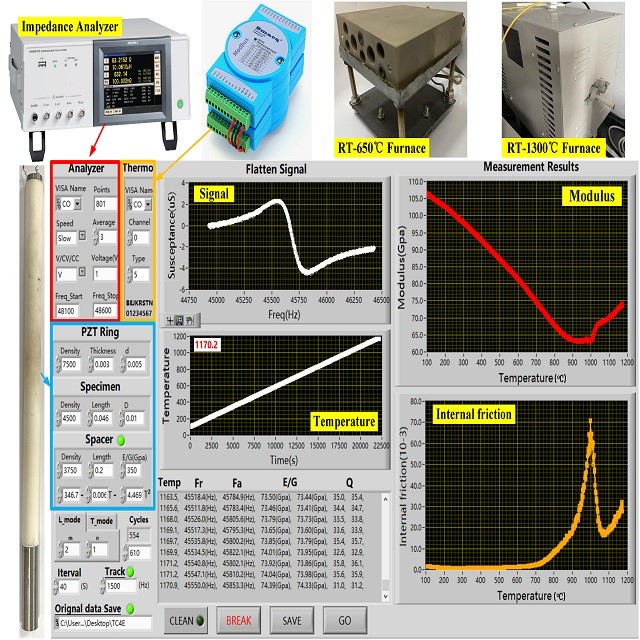Peking University, December 16, 2021: Recently, the Li Faxin Research Group of Peking University College of
Engineering developed the world's first dynamic mechanical analyzer
(DMA) suitable for hard materials (metals, ceramics, etc.), as shown in
Figure 1 below. The instrument is based on the electro-mechanical
impedance method which can quickly, accurately, and automatically
measure Young's modulus, shear modulus, and corresponding internal
friction of materials under variable temperature conditions. The advent
of the instrument has brought good news to the high and low-temperature
mechanical analysis in the fields of superalloys (ceramics), composites,
functional materials, and amorphous alloys. It also means that China
has achieved an internationally leading position in this field. The
first author to complete the work is Xie Mingyu, a 2018 doctoral student
of the same research group.

Hard material DMA based on electro-mechanical impedance method and its automatic measurement software interface
Modulus and internal friction (or damping) are the basic physical
properties of all solid materials. Their changes with temperature can
accurately reflect the internal evolution of materials, such as atomic
diffusion, grain boundary sliding, solid-state phase transition, etc.
However, there is a lack of methods and instruments that can accurately
measure material modulus and internal friction at the same time.
Commercial DMA can only be used to measure polymer soft materials with
small modulus and large damping, but the measurement results of hard
materials are inaccurate, especially since the measurement deviation of
internal friction is very large. At present, the measurement method of
hard material modulus is mainly the free beam vibration method of the
American ASTM standard, but the accuracy of this method is very poor.
The internal friction of hard materials is mainly measured by the
Ke-type pendulum method proposed by the famous metal physicist Ke
Ting-sui, but this method can only measure the torsional internal
friction of filament samples. Its measurement of shear modulus is not
accurate, and the measurement process is cumbersome, so it is difficult
to realize automatic measurement.
Prof. Li Faxin’s group proposed a modulus and internal friction
measurement method based on electro-mechanical impedance method, which
can accurately and quickly measure the Young's modulus, shear modulus,
and corresponding internal friction of materials (Rev SciInstrum 2020,
Editor’s Pick, https://doi.org/10.1063/1.5135360;J App Phys 2020, Invited Perspective & Featured Article, https://doi.org/10.1063/5.0034801).
On this basis, they realized automatic measurement, increased the
measurement temperature to 1300 ⁰ C, and developed this high-temperature
DMA suitable for hard materials. In fact, this method is not sensitive
to temperature, as long as the temperature of the heating furnace can be
reached, there is no problem if the measurement range is above 2000 ⁰
C.
Using this new DMA, the research group obtained the grain boundary
sliding internal friction peak in polycrystalline pure aluminum under
high-frequency vibration (tens of kHz) for the first time, and the peak
temperature reached nearly 500 ⁰ C, which is much higher than the
low-frequency internal friction peak (285 ⁰ C) discovered by academician
Ke Ting-sui in 1947 (Xie, Li, J Alloy Comp 2021, https://doi.org/10.1016/j.jallcom.2021.159556).
Figure 2 shows the results of measuring the modulus and internal
friction of TC4 titanium alloy from room temperature to 1200 ⁰ C using
the new DMA. It can be seen from the figure that near 990 ⁰ C, both
moduli reach the minimum and both internal friction peak, indicating
that the material has undergone a solid-state phase transition
(transformation from the α+β mixed phase to β phase). It can also be
observed that when the material temperature rises above 700 ⁰ C, the
internal friction begins to rise sharply, which indicates that the
working temperature of TC4 must not exceed 700 ⁰ C. This work was
recently published online in an authoritative journal in the field of
metal materials (https://doi.org/10.1016/j.scriptamat.2021.114435).

Moduli
and internal friction spectrum of TC4 titanium alloy from room
temperature to 1200 ⁰ C. Young's modulus and longitudinal vibration
internal friction (left); shear modulus and torsional internal friction
(right).
Written by: Cherlin Xu
Edited by: Ng Joong Hwee, Fu Jiaqi
Source: PKU News (Chinese)

